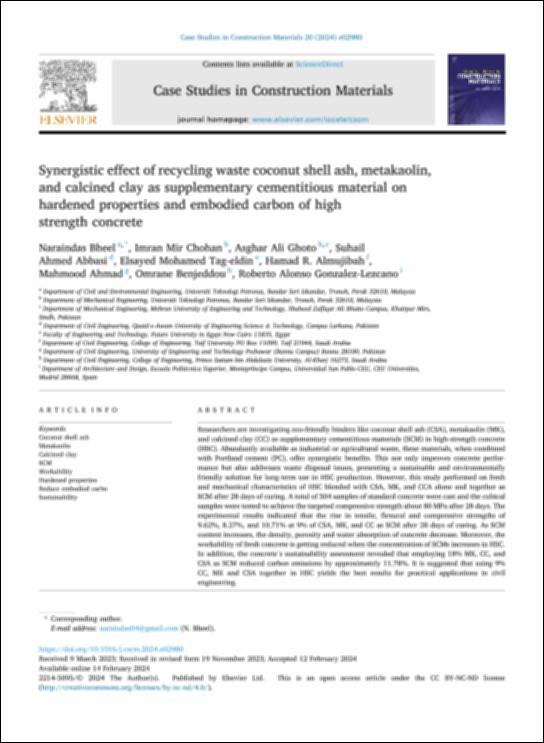Por favor, use este identificador para citar o enlazar este ítem:
http://hdl.handle.net/10637/15727Synergistic effect of recycling waste coconut shell ash, metakaolin, and calcined clay as supplementary cementitious material on hardened properties and embodied carbon of high strength concrete
| Título : | Synergistic effect of recycling waste coconut shell ash, metakaolin, and calcined clay as supplementary cementitious material on hardened properties and embodied carbon of high strength concrete |
| Autor : | Bheel, Naraindas Mir Chohan, Imran Ali Ghoto, Asghar Ahmed Abbasi, Suhail Tag-eldin, Elsayed Mohamed Almujibah, Hamad R. Ahmad, Mahmood Benjeddou, Omrane González Lezcano, Roberto Alonso. |
| Materias: | Sustainability; Metakaolin; Workability |
| Editorial : | Elsevier |
| Citación : | Naraindas Bheel, Imran Mir Chohan, Asghar Ali Ghoto, Suhail Ahmed Abbasi, Elsayed Mohamed Tag-eldin, Hamad R. Almujibah, Mahmood Ahmad, Omrane Benjeddou, Roberto Alonso Gonzalez-Lezcano, Synergistic effect of recycling waste coconut shell ash, metakaolin, and calcined clay as supplementary cementitious material on hardened properties and embodied carbon of high strength concrete, Case Studies in Construction Materials, Volume 20, 2024, e02980, ISSN 2214-5095, https://doi.org/10.1016/j.cscm.2024.e02980. |
| Resumen : | Researchers are investigating eco-friendly binders like coconut shell ash (CSA), metakaolin (MK), and calcined clay (CC) as supplementary cementitious materials (SCM) in high-strength concrete (HSC). Abundantly available as industrial or agricultural waste, these materials, when combined with Portland cement (PC), offer synergistic benefits. This not only improves concrete performance but also addresses waste disposal issues, presenting a sustainable and environmentally friendly solution for long-term use in HSC production. However, this study performed on fresh and mechanical characteristics of HSC blended with CSA, MK, and CCA alone and together as SCM after 28 days of curing. A total of 504 samples of standard concrete were cast and the cubical samples were tested to achieve the targeted compressive strength about 80 MPa after 28 days. The experimental results indicated that the rise in tensile, flexural and compressive strengths of 9.62%, 8.27%, and 10.71% at 9% of CSA, MK, and CC as SCM after 28 days of curing. As SCM content increases, the density, porosity and water absorption of concrete decrease. Moreover, the workability of fresh concrete is getting reduced when the concentration of SCMs increases in HSC. In addition, the concrete’s sustainability assessment revealed that employing 18% MK, CC, and CSA as SCM reduced carbon emissions by approximately 11.78%. It is suggested that using 9% CC, MK and CSA together in HSC yields the best results for practical applications in civil engineering. |
| URI : | http://hdl.handle.net/10637/15727 |
| Derechos: | http://creativecommons.org/licenses/by-nc-nd/4.0/deed.es Open Access |
| ISSN : | 2214-5095 |
| Fecha de publicación : | 14-feb-2024 |
| Centro : | Universidad San Pablo-CEU |
| Aparece en las colecciones: | Escuela de Politécnica Superior |
Los ítems de DSpace están protegidos por copyright, con todos los derechos reservados, a menos que se indique lo contrario.


